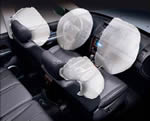Orange County Defective Airbag Lawyer
 Airbags are supposed to save lives. After the initial impact in a car accident, airbags should deploy to help prevent second-impact injuries to passengers. Defective airbag systems can result in no protection or, even worse, may contribute to the severity of second impact injuries.
Airbags are supposed to save lives. After the initial impact in a car accident, airbags should deploy to help prevent second-impact injuries to passengers. Defective airbag systems can result in no protection or, even worse, may contribute to the severity of second impact injuries.
If you or someone you love has been injured or killed as a result of a defective airbag system, you may be entitled to seek compensation for your damages including pain and suffering, medical costs, and more. Please contact us today to consult with an experienced and trusted Orange County defective airbag attorney at Aitken * Aitken * Cohn about your legal rights and options. We can evaluate your case at no cost to determine the best course of action.
Types of Defective Airbags
There are several different types of airbag defects that can cause serious injury or death to a vehicle passenger. Types of defects include, but are not limited to:
- Oversized airbags can strike a passenger upon inflation, causing head, brain and eye injuries.
- Untethered airbags don’t contain a strap to minimize movement.
- Airbag deployment failure: Typically, airbags are designed to deploy during impacts that occurred over 25 mph. Sometimes the airbag fails, resulting in serious injuries or even death.
- Unnecessary airbag deployment: Airbags that deploy in minor accidents such as running into a curb can result in passenger injury.
- Under-inflated airbag deployment occurs when the airbag fails to inflate to full size
- Front-mounted airbag deployment: During initial deployment, an airbag is a dangerous object traveling at over 200 mph. If the airbag is set to inflate directly at the passenger (rather than upward toward the windshield), serious injuries can occur.
Defective airbag systems could be a result of cheap materials (including sensors), the failure to incorporate new technology, poorly designed deployment devices and more. Automakers are responsible for ensuring their products, including airbags, are safe and effective and will be held liable for any injuries sustained as a consequence of a defective airbag system.
Speak with an Orange County Defective Airbag Attorney
If you or a loved one has been involved in an automobile accident and suffered harm as a result of a defective airbag system, we can help. The distinguished Orange County personal injury lawyers at Aitken * Aitken * Cohn have the knowledge and skills necessary to thoroughly investigate your case and get you the compensation you deserve for your losses. Please contact us today for a FREE case consultation.

